-
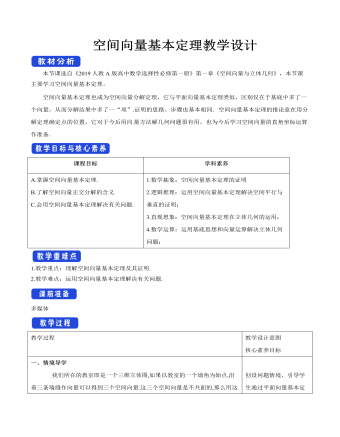
空间向量基本定理教学设计人教A版高中数学选择性必修第一册
反思感悟用基底表示空间向量的解题策略1.空间中,任一向量都可以用一个基底表示,且只要基底确定,则表示形式是唯一的.2.用基底表示空间向量时,一般要结合图形,运用向量加法、减法的平行四边形法则、三角形法则,以及数乘向量的运算法则,逐步向基向量过渡,直至全部用基向量表示.3.在空间几何体中选择基底时,通常选取公共起点最集中的向量或关系最明确的向量作为基底,例如,在正方体、长方体、平行六面体、四面体中,一般选用从同一顶点出发的三条棱所对应的向量作为基底.例2.在棱长为2的正方体ABCD-A1B1C1D1中,E,F分别是DD1,BD的中点,点G在棱CD上,且CG=1/3 CD(1)证明:EF⊥B1C;(2)求EF与C1G所成角的余弦值.思路分析选择一个空间基底,将(EF) ?,(B_1 C) ?,(C_1 G) ?用基向量表示.(1)证明(EF) ?·(B_1 C) ?=0即可;(2)求(EF) ?与(C_1 G) ?夹角的余弦值即可.(1)证明:设(DA) ?=i,(DC) ?=j,(DD_1 ) ?=k,则{i,j,k}构成空间的一个正交基底.

点到直线的距离公式教学设计人教A版高中数学选择性必修第一册
4.已知△ABC三个顶点坐标A(-1,3),B(-3,0),C(1,2),求△ABC的面积S.【解析】由直线方程的两点式得直线BC的方程为 = ,即x-2y+3=0,由两点间距离公式得|BC|= ,点A到BC的距离为d,即为BC边上的高,d= ,所以S= |BC|·d= ×2 × =4,即△ABC的面积为4.5.已知直线l经过点P(0,2),且A(1,1),B(-3,1)两点到直线l的距离相等,求直线l的方程.解:(方法一)∵点A(1,1)与B(-3,1)到y轴的距离不相等,∴直线l的斜率存在,设为k.又直线l在y轴上的截距为2,则直线l的方程为y=kx+2,即kx-y+2=0.由点A(1,1)与B(-3,1)到直线l的距离相等,∴直线l的方程是y=2或x-y+2=0.得("|" k"-" 1+2"|" )/√(k^2+1)=("|-" 3k"-" 1+2"|" )/√(k^2+1),解得k=0或k=1.(方法二)当直线l过线段AB的中点时,A,B两点到直线l的距离相等.∵AB的中点是(-1,1),又直线l过点P(0,2),∴直线l的方程是x-y+2=0.当直线l∥AB时,A,B两点到直线l的距离相等.∵直线AB的斜率为0,∴直线l的斜率为0,∴直线l的方程为y=2.综上所述,满足条件的直线l的方程是x-y+2=0或y=2.

两条平行线间的距离教学设计人教A版高中数学选择性必修第一册
一、情境导学前面我们已经得到了两点间的距离公式,点到直线的距离公式,关于平面上的距离问题,两条直线间的距离也是值得研究的。思考1:立定跳远测量的什么距离?A.两平行线的距离 B.点到直线的距离 C. 点到点的距离二、探究新知思考2:已知两条平行直线l_1,l_2的方程,如何求l_1 〖与l〗_2间的距离?根据两条平行直线间距离的含义,在直线l_1上取任一点P(x_0,y_0 ),,点P(x_0,y_0 )到直线l_2的距离就是直线l_1与直线l_2间的距离,这样求两条平行线间的距离就转化为求点到直线的距离。两条平行直线间的距离1. 定义:夹在两平行线间的__________的长.公垂线段2. 图示: 3. 求法:转化为点到直线的距离.1.原点到直线x+2y-5=0的距离是( )A.2 B.3 C.2 D.5D [d=|-5|12+22=5.选D.]

圆的一般方程教学设计人教A版高中数学选择性必修第一册
情境导学前面我们已讨论了圆的标准方程为(x-a)2+(y-b)2=r2,现将其展开可得:x2+y2-2ax-2bx+a2+b2-r2=0.可见,任何一个圆的方程都可以变形x2+y2+Dx+Ey+F=0的形式.请大家思考一下,形如x2+y2+Dx+Ey+F=0的方程表示的曲线是不是圆?下面我们来探讨这一方面的问题.探究新知例如,对于方程x^2+y^2-2x-4y+6=0,对其进行配方,得〖(x-1)〗^2+(〖y-2)〗^2=-1,因为任意一点的坐标 (x,y) 都不满足这个方程,所以这个方程不表示任何图形,所以形如x2+y2+Dx+Ey+F=0的方程不一定能通过恒等变换为圆的标准方程,这表明形如x2+y2+Dx+Ey+F=0的方程不一定是圆的方程.一、圆的一般方程(1)当D2+E2-4F>0时,方程x2+y2+Dx+Ey+F=0表示以(-D/2,-E/2)为圆心,1/2 √(D^2+E^2 "-" 4F)为半径的圆,将方程x2+y2+Dx+Ey+F=0,配方可得〖(x+D/2)〗^2+(〖y+E/2)〗^2=(D^2+E^2-4F)/4(2)当D2+E2-4F=0时,方程x2+y2+Dx+Ey+F=0,表示一个点(-D/2,-E/2)(3)当D2+E2-4F0);
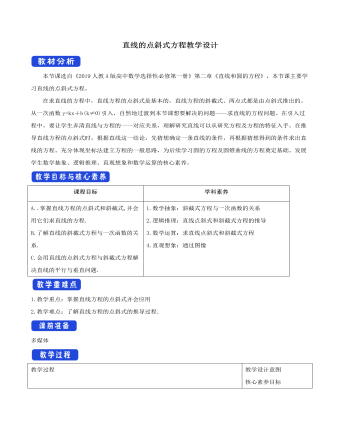
直线的点斜式方程教学设计人教A版高中数学选择性必修第一册
【答案】B [由直线方程知直线斜率为3,令x=0可得在y轴上的截距为y=-3.故选B.]3.已知直线l1过点P(2,1)且与直线l2:y=x+1垂直,则l1的点斜式方程为________.【答案】y-1=-(x-2) [直线l2的斜率k2=1,故l1的斜率为-1,所以l1的点斜式方程为y-1=-(x-2).]4.已知两条直线y=ax-2和y=(2-a)x+1互相平行,则a=________. 【答案】1 [由题意得a=2-a,解得a=1.]5.无论k取何值,直线y-2=k(x+1)所过的定点是 . 【答案】(-1,2)6.直线l经过点P(3,4),它的倾斜角是直线y=3x+3的倾斜角的2倍,求直线l的点斜式方程.【答案】直线y=3x+3的斜率k=3,则其倾斜角α=60°,所以直线l的倾斜角为120°.以直线l的斜率为k′=tan 120°=-3.所以直线l的点斜式方程为y-4=-3(x-3).
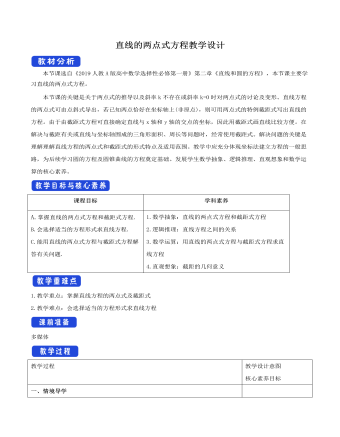
直线的两点式方程教学设计人教A版高中数学选择性必修第一册
解析:①过原点时,直线方程为y=-34x.②直线不过原点时,可设其方程为xa+ya=1,∴4a+-3a=1,∴a=1.∴直线方程为x+y-1=0.所以这样的直线有2条,选B.答案:B4.若点P(3,m)在过点A(2,-1),B(-3,4)的直线上,则m= . 解析:由两点式方程得,过A,B两点的直线方程为(y"-(-" 1")" )/(4"-(-" 1")" )=(x"-" 2)/("-" 3"-" 2),即x+y-1=0.又点P(3,m)在直线AB上,所以3+m-1=0,得m=-2.答案:-2 5.直线ax+by=1(ab≠0)与两坐标轴围成的三角形的面积是 . 解析:直线在两坐标轴上的截距分别为1/a 与 1/b,所以直线与坐标轴围成的三角形面积为1/(2"|" ab"|" ).答案:1/(2"|" ab"|" )6.已知三角形的三个顶点A(0,4),B(-2,6),C(-8,0).(1)求三角形三边所在直线的方程;(2)求AC边上的垂直平分线的方程.解析(1)直线AB的方程为y-46-4=x-0-2-0,整理得x+y-4=0;直线BC的方程为y-06-0=x+8-2+8,整理得x-y+8=0;由截距式可知,直线AC的方程为x-8+y4=1,整理得x-2y+8=0.(2)线段AC的中点为D(-4,2),直线AC的斜率为12,则AC边上的垂直平分线的斜率为-2,所以AC边的垂直平分线的方程为y-2=-2(x+4),整理得2x+y+6=0.
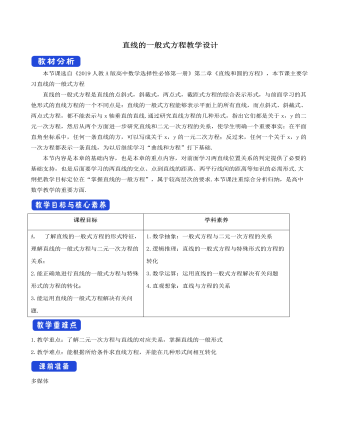
直线的一般式方程教学设计人教A版高中数学选择性必修第一册
解析:当a0时,直线ax-by=1在x轴上的截距1/a0,在y轴上的截距-1/a>0.只有B满足.故选B.答案:B 3.过点(1,0)且与直线x-2y-2=0平行的直线方程是( ) A.x-2y-1=0 B.x-2y+1=0C.2x+y=2=0 D.x+2y-1=0答案A 解析:设所求直线方程为x-2y+c=0,把点(1,0)代入可求得c=-1.所以所求直线方程为x-2y-1=0.故选A.4.已知两条直线y=ax-2和3x-(a+2)y+1=0互相平行,则a=________.答案:1或-3 解析:依题意得:a(a+2)=3×1,解得a=1或a=-3.5.若方程(m2-3m+2)x+(m-2)y-2m+5=0表示直线.(1)求实数m的范围;(2)若该直线的斜率k=1,求实数m的值.解析: (1)由m2-3m+2=0,m-2=0,解得m=2,若方程表示直线,则m2-3m+2与m-2不能同时为0,故m≠2.(2)由-?m2-3m+2?m-2=1,解得m=0.
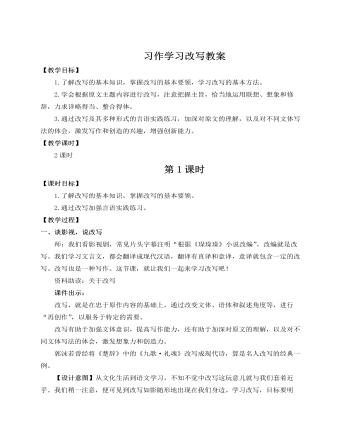
人教部编版语文九年级上册写作学习改写教案
有一天正午正走在黄泥冈上,他们又要喊歇,我自知这一带劫匪出没甚多,便催促他们快走,可他们却坐在地上不动了,任凭我怎样拿鞭抽打,他们也不起来,无奈之下,只得让他们歇会儿。不一会儿,来了一个卖酒的人过来,有人要买酒。被我阻止了,我说这酒里不知放了什么,还是不要喝的好。又一会儿来了几个贩枣的客商,先买了一桶酒,又把另一桶打开喝了一瓢。另一个客人见了,也拿瓢来舀酒。卖酒的见了,抢过瓢来,劈手将酒倒在桶里。殊不知,就在这时,蒙汗药被放进了桶里。老总管过来问我:“杨提辖,你看他们喝了都没事,我们也渴了,就买点吧。”我思量着,这一桶也被喝过,应该没事,只得同意了。于是他们便冲上去买酒,有人还给了我一瓢,我接下来喝了。这时我看他们一个个都头重脚轻栽倒在地上,心里暗叫:不好,中计了。但再想站起来,已经不可能了,看见那群“商人”,一个个笑着,我真是懊悔,没让队伍继续走,还有那些不听我话的人,为什么不听我话,又一次任务失败了,回去怎么交代……不一会儿我眼前一片漆黑,什么也不知道了。醒来后,周围一个人也没有,而生辰纲果然不见了,无奈之下,我只能逃走,却不知何处是终点……
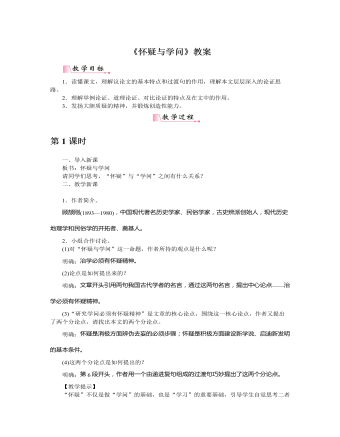
部编版语文九年级上册《怀疑与学问》教案
一、复习回顾、引入新课上节课,我们学习了《怀疑与学问》的内容,也学习了议论文结构的基本特征以及常用的论证方法,这节课我们重点学习议论文在论证论点过程中说理的层次,还要进一步理解议论文分析事理透辟,语言严密的特点。二、教学新课目标导学一:探究说理的层次,明确各段之间的关系请同学们细读课文,边读边思考句与句之间的关系,分组完成以下问题。1.本文论点是“治学必须有怀疑精神”,作者是如何阐述怀疑精神的?明确:对怀疑精神作者阐述得明确而透彻:所谓疑就是决不轻信,经过思考,分清是非,再决定信与不信;进而把怀疑科学地分为“怀疑”“思索”“辨别”三步。2.结合课文思考:作者是如何阐述“从怀疑到创新”这一治学过程的?明确:作者在进一步论证“怀疑是建设新学说、启迪新发明的基本条件”时,又把怀疑到创新的治学过程分析为“怀疑、辩论、评判、修正、创新”。作者通过举例、正反说理,使内容阐述得鞭辟入里,无懈可击。
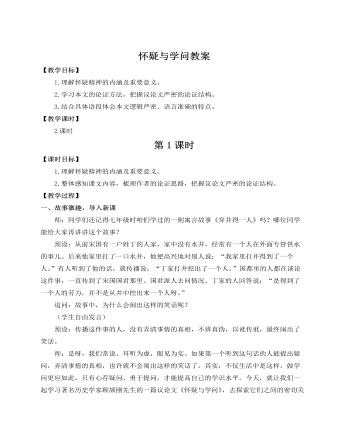
人教部编版语文九年级上册怀疑与学问教案
1.理解怀疑精神的内涵及重要意义。2.整体感知课文内容,梳理作者的论证思路,把握议论文严密的论证结构。【教学过程】一、故事激趣,导入新课师:同学们还记得七年级时咱们学过的一则寓言故事《穿井得一人》吗?哪位同学能给大家再讲讲这个故事?预设:从前宋国有一户姓丁的人家,家中没有水井,经常有一个人在外面专管供水的事儿。后来他家里打了一口水井,他便高兴地对别人说:“我家里打井得到了一个人。”有人听到了他的话,就传播说:“丁家打井挖出了一个人。”国都里的人都在谈论这件事,一直传到了宋国国君那里。国君派人去问情况。丁家的人回答说:“是得到了一个人的劳力,并不是从井中挖出来一个人呀。”追问:故事中,为什么会闹出这样的笑话呢?(学生自由发言)预设:传播这件事的人,没有弄清事情的真相,不辨真伪,以讹传讹,最终闹出了笑话。

新人教版高中英语选修2Unit 2 Learning about Language教学设计
The activity theme of this section is to design various activities around the key words in the first text. Therefore, the activities require students to pay attention to the spelling of words. On the other hand, let students grasp the meaning of words more accurately through sentences and short texts. This kind of teaching design also helps to improve the ability of using English thinking.1. Cultivating students' ability to use word formation to induce and memorize vocabulary, and the ability to use lexical chunks to express meaning.2. Guide the students to think independently and use the correct form of words to complete sentences3. Cultivate students' habit of using lexical chunks to express language completely, guide students to draw words in sentences quickly, pay attention to word collocation, so as to accumulate more authentic expressions4. Instruct students to create sentences with the chunks.1. Enable students to use the language points in the real situation or specific contexts flexibly and appropriately.2. Guiding the Ss to use unit topic words and the sentence patterns in a richer context.Step1: Think of a word that best fits each definition.1. to remember sth2.to accept, admit, or recognize sth or the truth/existence of sth3. the process of changing sth or yourself to suit a new situation4 .to make sb feel less worried or unhappy5. a strong desire to achieve sth

新人教版高中英语选修2Unit 2 Reading and thinking教学设计
Her tutor told her to acknowledge __________ other people had said if she cited their ideas, and advised her _______(read) lots of information in order to form __________wise opinion of her own.Now halfway __________ her exchange year, Xie Lei felt much more at home in the UK. She said __________ (engage) in British culture had helped and that she had been__________ (involve) in social activities. She also said while learning about business, she was acting as a cultural messenger __________(build) a bridge between the two countries. keys:Xie Lei, a 19yearold Chinese student, said goodbye to her family and friends in China and boarded (board) a plane for London six months ago in order to get a business qualification. She was ambitious(ambition) to set up a business after graduation. It was the first time that she had left (leave) home.At first, Xie Lei had to adapt to life in a different country. She chose to live with a host family, who can help with her adaptation (adapt) to the new culture. When she missed home, she felt comforted (comfort) to have a second family. Also Xie Lei had to satisfy academic requirements. Her tutor told her to acknowledge what other people had said if she cited their ideas, and advised her to read lots of information in order to form a wise opinion of her own.Now halfway through her exchange year, Xie Lei felt much more at home in the UK. She said engaging (engage) in British culture had helped and that she had been involved (involve) in social activities. She also said while learning about business, she was acting as a cultural messenger building a bridge between the two countries.

新人教版高中英语选修2Unit 2 Reading for writing教学设计
The theme of this section is to express people's views on studying abroad. With the continuous development of Chinese economic construction, especially the general improvement of people's living standards, the number of Chinese students studying abroad at their own expense is on the rise. Many students and parents turn their attention to the world and regard studying abroad as an effective way to improve their quality, broaden their horizons and master the world's advanced scientific knowledge, which is very important for the fever of going abroad. Studying abroad is also an important decision made by a family for their children. Therefore, it is of great social significance to discuss this issue. The theme of this section is the column discussion in the newspaper: the advantages and disadvantages of studying abroad. The discourse is about two parents' contribution letters on this issue. They respectively express their own positions. One thinks that the disadvantages outweigh the advantages, and the other thinks that the advantages outweigh the disadvantages. The two parents' arguments are well founded and logical. It is worth noting that the two authors do not express their views on studying abroad from an individual point of view, but from a national or even global point of view. These two articles have the characteristics of both letters and argumentative essays1.Guide the students to read these two articles, and understand the author's point of view and argument ideas2.Help the students to summarize the structure and writing methods of argumentative writing, and guides students to correctly understand the advantages and disadvantages of studying abroad3.Cultivate students' ability to analyze problems objectively, comprehensively and deeply

新人教版高中英语选修2Unit 2 Using langauge-Listening教学设计
? B: Absolutely! Getting involved with Chinese cultural activities there definitely helped a lot. I got to practice my Chinese on a daily basis, and I could learn how native Chinese speakers spoke.? A: What do you feel is your biggest achievement?? B: Learning Chinese characters! I have learnt about 1,500 so far. When I first started, I didn't think it was even going to be possible to learn so many, but now I find that I can read signs, menus, and even some easy newspaper articles.? A: What are you most keen on?? B: I've really become keen on learning more about the Chinese culture, in particular Chinese calligraphy. As I have learnt Chinese characters, I have developed a great appreciation for their meaning. I want to explore Chinese characters by learning how to write them in a more beautiful way. ? A: Finally, what do you want to say to anyone interested in learning Chinese?? I have really become keen on learning more about the Chinese culture, in particular Chinese Calligraphy. As I have learnt Chinese character, I have developed a great appreciation for their meaning. I want to explore Chinese characters by learning how to write them in a more beautiful way.? A: Finally, what do you want to say to anyone interested in learning Chinese?? B: I'd say, give it a shot! While some aspects may be difficult, it is quite rewarding and you will be happy that you tried.? A: Thanks for your time. ? B:You're welcome.
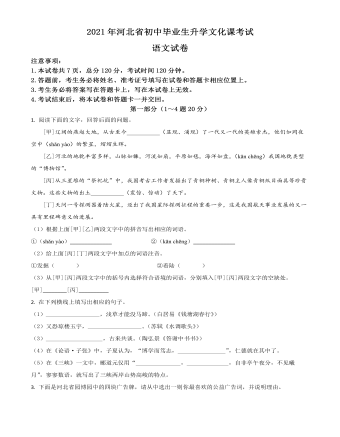
河北省2021年中考语文试题(原卷版)
初学古文,势必会遇到一些文字障碍,这就好像是遇到了拦路虎。有的人见了被吓倒而退缩,不再读下去;有的人见了就千方百计努力擒住它、降伏它,扫清障碍向前,顺利地读下去了。那些完全陌生的难解语词,现代汉语中已见不到或很少见到,这倒是不难对付的。翻检词典、查看注解、请教旁人,都是解决的办法。
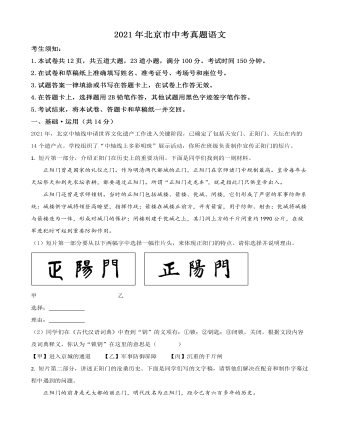
北京市2021年中考语文试题(解析版)
黄鹤楼崔颢昔人已乘黄鹤去,此地空余黄鹤楼。黄鹤一去不复返,白云千载空悠悠。晴川历历汉阳树,芳草萋萋鹦鹉洲。日暮乡关何处是?烟波江上使人愁。

北京市2021年中考语文试题(原卷版)
初,遇①善治《老子》。人有从学者,遇不肯教,而云“必当先读百遍”。从学者云:“苦渴无日。”遇言:“当以三余。”或问三余之意,遇言:“冬者岁之余,夜者日之余,阴雨者时之余也。”(取材于《三国志·魏志·王肃传》裴松之注)
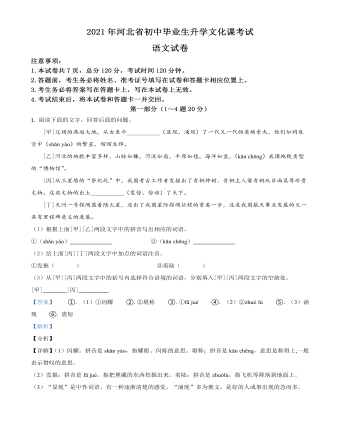
河北省2021年中考语文试题(解析版)
蔡元定①八岁能诗,及长,登泰山绝顶。日惟啖②荠③。于书无不读,朱熹扣④其学,大惊曰:“此吾老友也,不当在弟子列。”

2022年河北省中考英语真题(原卷版)
As a boy, Kevin visited national parks and helearned the Earth is in ___12___ condition. He felt worried, and hewanted to ___13___ the Earth. In 2009, he went to swim in water nearNorth Pole(北极)todraw people’s attention to the melting glaciers(融化的冰川).
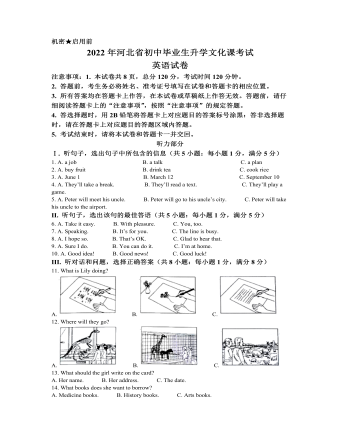
2022年河北省中考英语真题(解析版)
As a boy, Kevin visited national parks and helearned the Earth is in ___12___condition. He felt worried, and he wanted to ___13___ the Earth. In 2009, he went to swim in waternear North Pole(北极)todraw people’s attention to the melting glaciers(融化的冰川).



